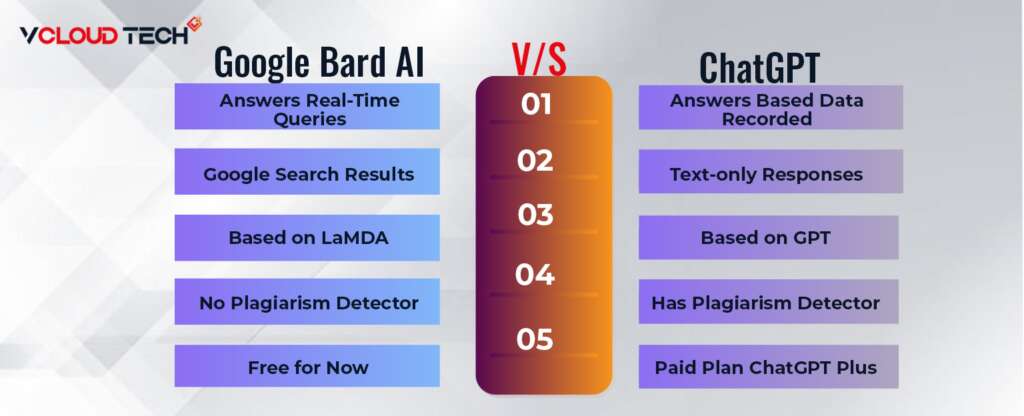The Revolutions of AI
Google Bard AI and OpenAI ChatGPT used Artificial Intelligence (AI) language models, but with some key differences. A few days ago, Google announced the Google Bard AI chatbot, rivaling OpenAI’s chat GPT model.
Google Bard AI is a Language Model for Dialogue Applications developed by Google to generate high-quality text by predicting the next word in a given sentence based on context. It has been trained on a large corpus of text. And also can be fine-tuned to generate text in a specific range or style using a small dataset.
GPT-3 (Generative Pretrained Transformer-3) is the third generation of OpenAI language models. It trained on large amounts of text data to generate, summarize, translate, answer questions, and perform other tasks. It can run many natural languages.
The services offered by Google’s Bard and ChatGPT are similar. The user must enter a question, request, or prompt to receive a human-like response. Microsoft and Google plan to incorporate AI tools to power the search services of Bing and Google Search, which make up a large portion of their revenue.
Here are Some Critical Differences between Bard and ChatGPT:
Pricing and Availability:
There are free models for ChatGPT and Google Bard. ChatGPT is currently in a free research preview on OpenAI’s website (opens in new tab), but there is a paid subscription model called ChatGPT Plus, where users pay $20 for priority access and faster speeds. ChatGPT Plus is limited to those to whom OpenAI has approved access. So, you have to sign up for a waiting list to get access.
Conversely, Bard currently only has a free model, but you must be a “Trusted Tester” to access the AI chatbot. While Google has announced some AI-based features to add to products like Maps and Lens, Bard is still hidden from the public eye. Google expects public access to Bard to be announced: “in the coming weeks.”
Integration:
Microsoft, OpenAI, and Google want their chatbots to be integrated into their respective ecosystems as soon as possible. ChatGPT is already integrated into his three Microsoft products: Bing, Edge, and Teams.
Microsoft also recently introduced a new Bing, a version of the Bing search engine based on an updated version of GPT-3.5. Whether this is his rumored GPT 4 model or a slight upgrade is currently unknown, but Microsoft says it is an upgrade to his GPT 3.5 model that powers ChatGPT. This new version of Bing allows users to interact with Bing like a Chat GPT chatbot instead of being forced to use the traditional search bar. In addition, this version of Bing features Microsoft’s Edge browser, plus a sidebar where you can chat and create to provide insights. This feature helps consolidate large amounts of information on web pages into more manageable summaries.
We look forward to hearing more information about this particular integration.
The company just announced that Microsoft and ChatGPT would be integrated into the Opera web browser. Details on the launch schedule have yet to be revealed, but the new Bing will likely offer similar functionality to what it provides in the Edge browser.
Google’s Bard AI chatbot also integrates with Search, but in this case, with Google Search. Like Bing, users can search for queries from an AI-powered chatbot instead of a traditional search bar. Google also introduced AI-based tools in Lens and Maps, but these aren’t specific Google Bard integrations.
However, Google has announced that it will allow third-party developers to use Bard, so it will be interesting to see what other developers come up with. In addition, OpenAI allows certain companies access to its GPT-based functionality, but only Microsoft can access its source code outside of OpenAI.
How to Cite the Source:
Plagiarism is a significant issue when using chatbots such as ChatGPT or Google Bard. The AI language model that powers the chatbot must be trained on an existing knowledge base. That means chatbots are fed a large amount of content created by third parties. It is not uncommon to summarize research from primary and secondary sources alike into original content, but when doing this, it is necessary to cite where the information came from.
However, Chat GPT does not provide a source for the content it generates. You can give the start when properly prompted, but it’s not the default. Therefore, you should be very careful when using chatbots. Otherwise, you risk stealing your intellectual property unknowingly.
Bard also doesn’t provide citations for his responses per se. Can you do that?” Bard provided the answer (indicating it was wrong and upon further investigation). Say where the information came from. It was probably a website somewhere, but if your girlfriend’s 9-year-old took that information and didn’t quote it on their school report cards, they’d be in trouble.
Interestingly, Bing’s new GPT-based chatbot points to that source. We use footnotes to cite the website from which the information obtain, but you should click for more information. There are ethical concerns, but it’s still essentially stealing intellectual property. Because it comes from websites that need the traffic to make money and stay up to date on the Internet. But at least Bing didn’t plagiarize directly. Still, there’s no guarantee that the chatbot can quote everything you need, so great care should be taken.

Accuracy:
Chatbot AI makes mistakes. Regularly. That is only sometimes the case, but even Google’s bard AI demo got the question wrong. Google and Open AI have openly admitted that ChatGPT and Bard can provide inaccurate or inappropriate information.
That largely depends on how these chatbots work. For example, we use GPT-3.5 for ChatGPT and LaMDA for the Bard language model, and these language models need a lot of information to work. Hence, for GPT and LaMDA, much of this information is available on the Internet. For GPT-3.5, we only have until 2021, when Open AI will stop training language models. So, his version of GPT on Bing, like Bard AI, is more up-to-date as it gets its latest information from the Internet.
There is a problem with this training. That means that the information you get may be inaccurate or biased, and chatbots are not inherently trained to know this. Chatbots are trained to provide outputs associated with their inputs. Therefore, it is not possible to determine whether this information will give the correct answer or whether the solution provided is free of inherent bias.
Outlook:
At the moment, these AI chatbots are still very new. That means creating content that is impressive but still makes mistakes, pushes ethical and possibly legal boundaries, and still finds the best use cases. Still, the technology is awe-inspiring and, in the case of Bard or the GPT-based version of Bing, could revolutionize how we search for information on the web.
Unfortunately, if you want to experiment with new technology, you may be restricted to the accessible version of this Chat GPT on the OpenAI platform. ChatGPT Plus and the new Bing are on a waiting list, and Google Bard is still limited to trusted testers. That a change in the coming weeks or months, but for now, this remains an uncharted frontier that we are just beginning to experience.
FAQs:
What is a GPT Chatbot?
ChatGPT is an AI chatbot released by OpenAI to demonstrate and test what can be done with an extensive and powerful AI system. You can ask him a myriad of questions and often get helpful answers. For example, you can ask encyclopedias such as “Please explain Newton’s laws of motion.”
What is Google’s Bard AI?
Like his ChatGPT from OpenAI, Google Bard is a modern, experimental AI-powered chatbot that can interactively respond to various requests and demands. Fresh, high-quality answers should be generated by online information.
What is ChatGPT?
ChatGPT can enhance content creation and conversion automation while delivering a fast and engaging user experience. In addition, the easiest way to use ChatGPT is as a question-and-answer prompt.
How do I use Bard AI?
To use the BARD AI chatbot, which has been selected as a beta tester, open the Google app on your smartphone and tap the chatbot icon.
Is ChatGPT free?
ChatGPT is a sister model of InstructGPT, trained to follow command prompt instructions and provide detailed answers. We are happy to introduce ChatGPT to get user feedback and learn more about its strengths and weaknesses. ChatGPT is free to use during the research preview period.
Reach out to us and book a Free Consultation with vCloud Tech or chat with one of our representatives. Connect with us on Twitter, Facebook, Instagram, and LinkedIn for more information.









